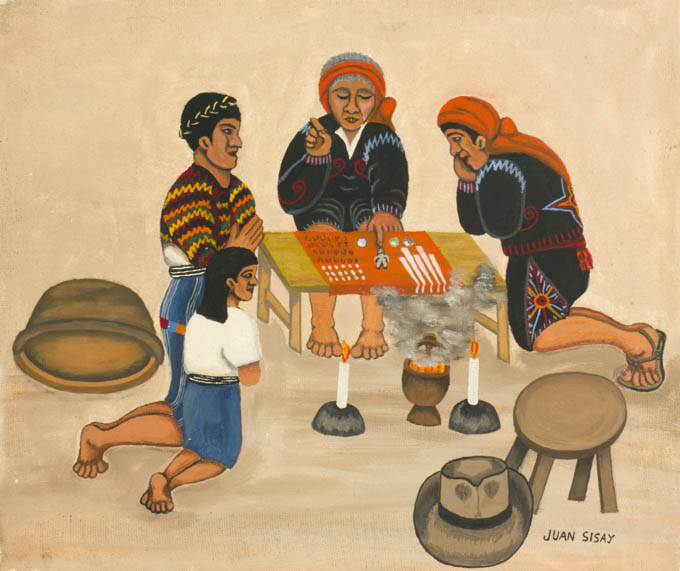|
Divination, by Juan Sisay, 1957.
Maya people frequently consult an ajq’iij (day keeper) prior to making an important decision or taking on a
large project with hope of having a good outcome. The woman and child in the painting do not wear the traje of Chichicastenango,
so they probably have travelled some distance to consult with the ajq’ijaab’ (plural form of the word, referring to all
elders who help, guide and work alongside the community) who are from Chichicastenango. Most likely this reading would be
arranged in advance so that the ajq’iij could select the most propitious day.
Before the reading starts the ajq’iij will ask questions of the participants. The reading is done on a special table, called
the santa mesa (holy table), which belongs to the ajq’iij. Here, he has an altar and performs special ceremonies. The ajq’iij
will then cover the table with a cloth, so as not to touch the table itself. He will then pray to the four directions, asking
the powers to remove any flaws in himself so that the reading will be accurate. At this point he will open his bag containing
the tz’ite seeds (seeds of the pito tree) and other divinatory objects and lay them on the table. He will also light candles
and burn incense. The color of the candles carries different intentions. The ajq’iij then randomly divides the seeds into two
groups. One group he puts into piles of four seeds each in regular rows, to represent the days of the calendar. He will then
ask questions pertaining to the person and their problem. In the end, the person asking for advice is often encouraged toward
their goals or instructed to go to a specific sacred site on a particular day to perform a special ritual. Around each of the
Maya towns there are many such sacred sites, each fulfilling its own spiritual function and theme (Tedlock 1992).
Tedlock, Barbara.1992. Time and the Highland Maya, Revised Edition. Albuquerque,.NM: University of New Mexico Press, 1992.
|
